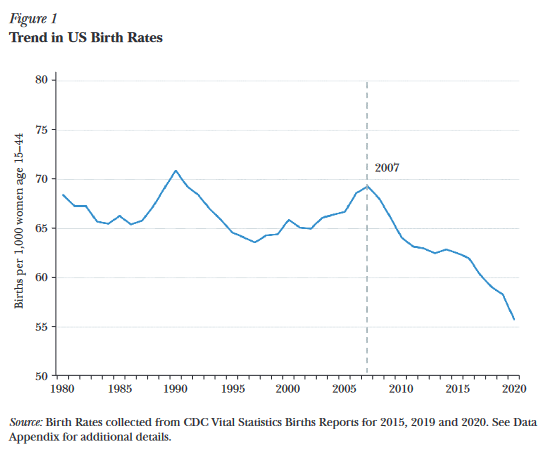Melissa Kearney evaluates pandemic birth rates in Time Magazine
A new article published in Time Magazine by Faculty Associate Melissa Kearney and Phillip Levine discusses shifts in birth rates during the COVID-19 pandemic.
Prior to the outbreak, birth rates in the United States has been on a long-term downward trend. In another article published by Kearney in the Journal of Economic Perspectives, results of an in-depth analysis suggested that this pattern likely reflects societal changes, as economic factors and US-specific policies did not explain the downward trend (Kearney, Levine, and Pardue, 2022).

Figure from Kearney, Melissa S., Phillip B. Levine, and Luke Pardue. "The Puzzle of Falling US Birth Rates since the Great Recession." Journal of Economic Perspectives 36.1 (2022): 151-76. https://doi.org/10.1257/jep.36.1.151
Did the pandemic disrupt this long-held trend?
At the start of the pandemic, the pregnancy rate decreased as the unemployment rate increased, likely due to economic strife and health concerns. The drop in pregnancies was the greatest for older women and women who already had at least one child. This finding may be explained by reduced access to fertility services and shut down daycares. Surprisingly, birth rates began dropping faster than expected (i.e., in the spring and summer of 2020 rather than later in the fall). Upon investigation, the authors found the reduction in pregnant women's entry to the United States due to travel restrictions to be possible cause.
Interestingly, once families began recouping economic security in the fall of 2020, pregnancies rebounded. Families' improved economic well-being through the federal government's offer of unemployment insurance benefits and income assistance, as well as a reduction in pandemic-related health anxiety, were both associated with a greater conception rate in the summer and fall of 2020 and the subsequent 2021 baby boom.
So where do we stand now? The COVID baby bust and rebound were small deviations, but today's data indicate that the United States has returned to its pre-pandemic long-term downward trend.
